Venus presents a stunning crescent at dusk before switching over to the morning sky early next month. After dodging the Moon for the Geminids, it’s dark skies all around for the Quadrantid meteor shower.
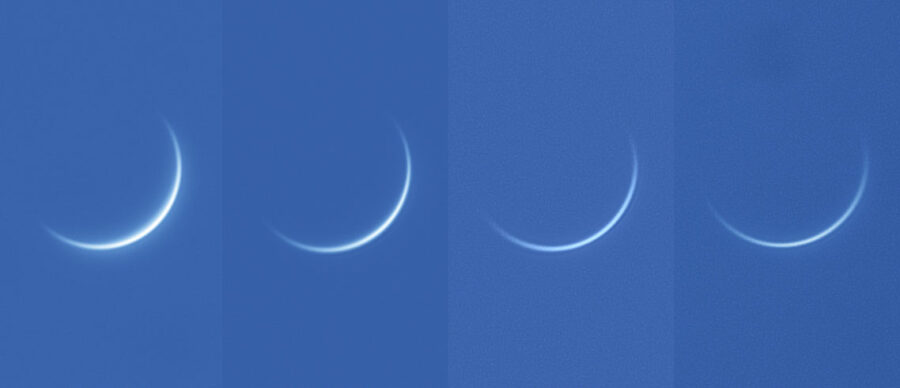
Shahrin Ahmad
Like the porch light that welcomes you home at night, the brightest nighttime planet has been part of the celestial evening scenery since May. But that's changing. Venus is slipping away, winding down its evening apparition and transitioning into the morning sky. Inferior conjunction, when the planet passes between the Earth and Sun, occurs on January 8th. Hard to believe but fewer than two weeks of evening visibility remain.
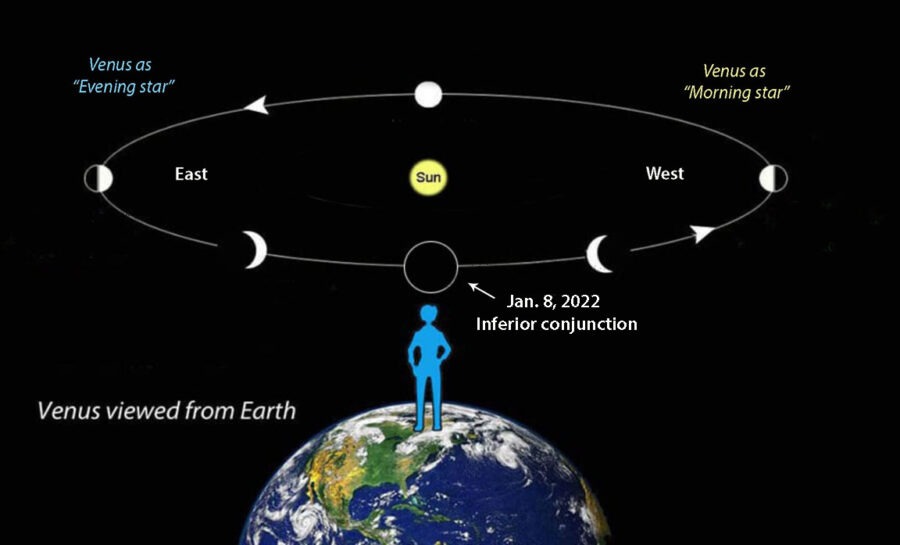
Bob King
Because Venus is an inner planet we see it from multiple angles over the course of its 225-day orbit. It can appear to the right and left of the Sun, as well as in front of and behind it. As the Earth-Venus-Sun angle varies, so does the planet's phase. When it's on the opposite side of the Sun and most distant from us, Venus resembles a tiny "full Moon." When between us and the Sun and closest, the planet's disk narrows to a hair-thin crescent big enough to see in 7×10 binoculars.
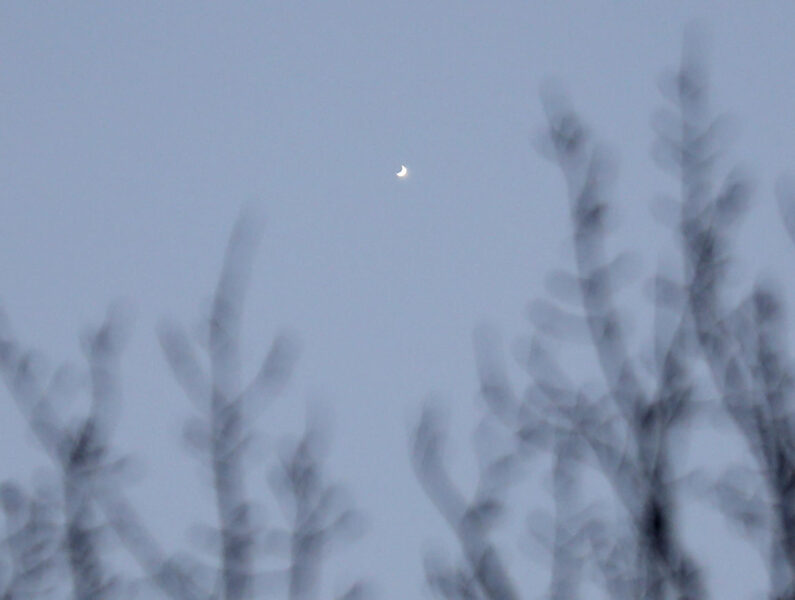
Bob King
On December 18th, I easily found the planet 10 minutes before sunset 29° east of the Sun. Like many amateurs I try to observe Venus in a relatively bright sky to tame its glare and also to catch it at peak altitude where image sharpness is less affected by atmospheric turbulence. If you wait for darkness, glare and air flutter make the crescent less distinct.
Between December 22nd and January 2nd, when Venus's elongation shrinks from 25° to just 10°, the crescent grows from 55″ to 60″. At the same time, the planet's illuminated portion decreases from 9.1% to 1.5%. In step with its decreasing elongation its altitude plummets, making it more and more difficult to fetch it from the twilight glow. How long you'll be able to follow the thinning arc will depend on sky clarity and the altitude of your local horizon.
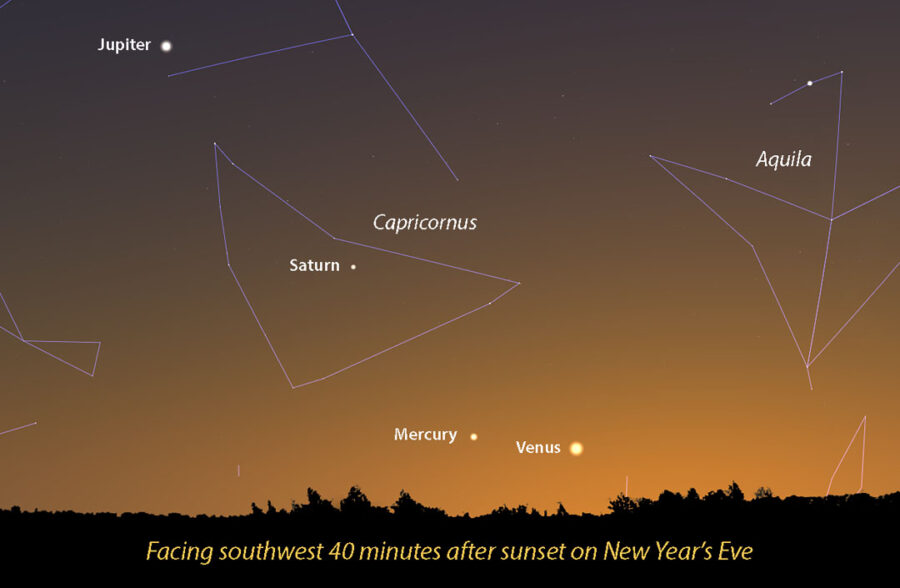
Stellarium
Closing in on the crescent
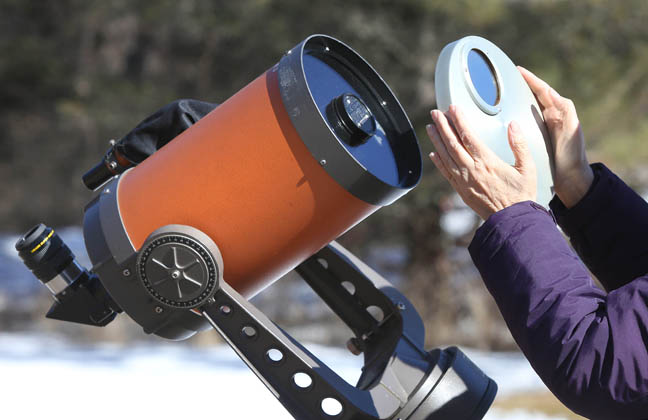
Bob King
When Venus's elongation narrows to 10° or less, you'll need a telescope to find the planet in the daytime sky. Pick a time when Venus is highest — early afternoon, when the planet crosses the meridian, is ideal. If you don't have a Go To mount, you can locate Venus using sky mapping software like Stellarium or its online web version and an equatorially-mounted telescope. Click on the planet and Sun for the right ascension (R.A.) and declination of each at the time of observation, then subtract their coordinates to determine the correct offset values. For example, on December 23rd at 1 p.m. EST:
Venus — R.A. 19h 51m, Dec. –20.2°
Sun — R.A. 18h 08m, Dec. –23.4°
Offset = 1h 43m east in R.A. and 3.2° north in Dec.

Stellarium with additions by Bob King
Place a safe solar filter over the end of your telescope, center and focus on the Sun, then offset in R.A. and Dec. using the mount's setting circles. Carefully remove the filter, and as long as the telescope is reasonably polar aligned, a smiling crescent should stare back.
A word of caution. When Venus's elongation narrows to around 6°, take great care in pointing the telescope or you may risk damaging your vision or optics. Use a long dew cap to reduce internal reflections and observe with a red filter or through sunglasses to reduce glare and darken the sky. Choose an eyepiece with a modest or narrow field of view, again to reduce solar glare as well as to lessen the chance of including the Sun in the view.
Most importantly, do not look directly at the Sun. Never let even the smallest sliver of direct sunlight enter the field of view. Observe slowly and deliberately at your comfort level. Some amateurs set up their telescope in the shade of a building and avoid the Sun altogether. By following these precautions, experienced observers should be able to safely view the planet right up to inferior conjunction on January 8th, when it passes 4.8° north of the Sun. For more safe viewing tips check out Ronald Stoyan's article on the topic.
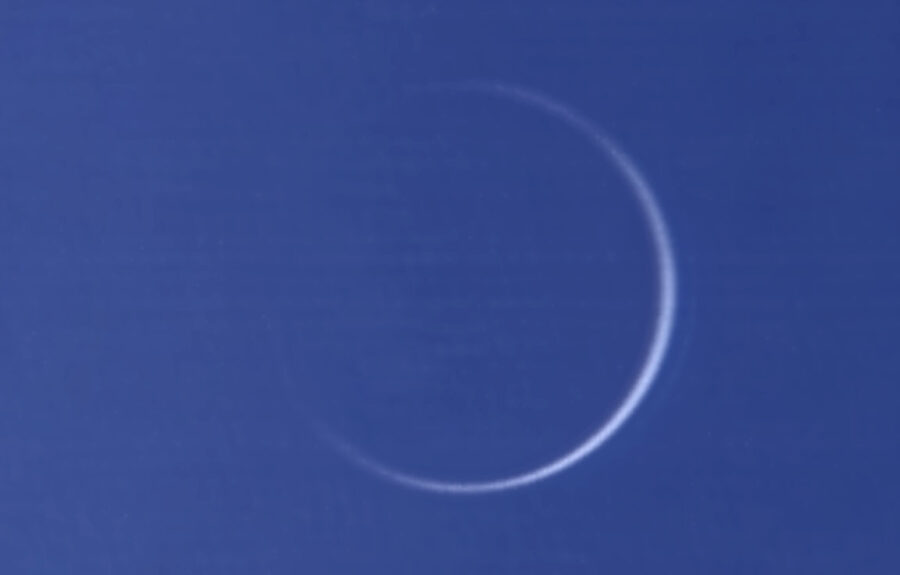
Shahrin Ahmad
I've observed the planet near inferior conjunction with care on several occasions. At these narrow separations, the crescent appears less than 1% illuminated, with the horns extending tip to tip around the disk to form a complete ring — an amazing if fleeting sight! Scattering and refraction of sunlight in the dense Venusian atmosphere create this unique phenomenon.
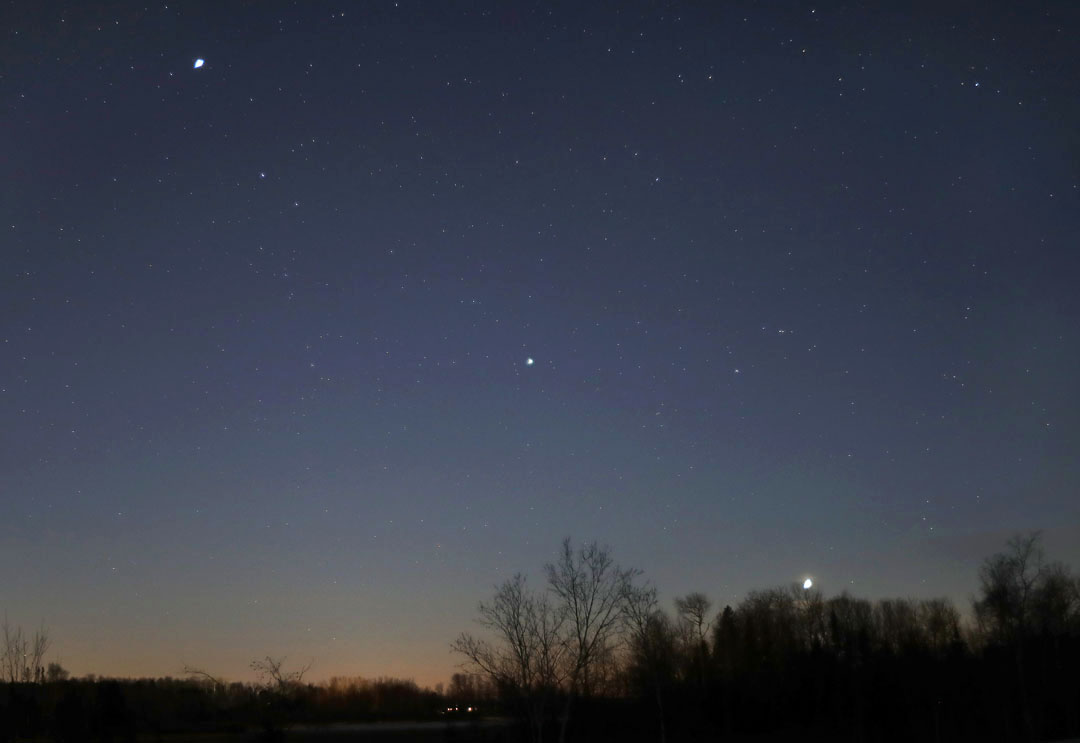
Bob King
After conjunction, Venus swings west of the Sun and into the dawn sky. On January 14th, the crescent will be 60″ across, 1.6% illuminated, and 10.7° from the Sun. Venus comes closer to Earth than any other planet. On January 8th it's just 24.7 million miles (39.8 million km) away. By making daytime observations before, during, and after conjunction you'll see how quickly the crescent rotates from one side of the disk to the other as the two planets approach and part.
Dark skies for the Quads
Unlike the Perseids or Geminids, where a good show is guaranteed so long as the Moon doesn't interfere, the annual Quadrantid meteor shower is more selective. Its peak is narrow — about 6 hours long — and the shower is only visible in the Northern Hemisphere in the small hours before dawn. If you're on the right slice of the planet at the right time, you might see as many as 100 meteors an hour under moonless skies. Elsewhere and that number drops to around 25 per hour. Even at that strength, the Quadrantids are still on par with the Lyrids and Orionids, sturdy showers worth viewing.
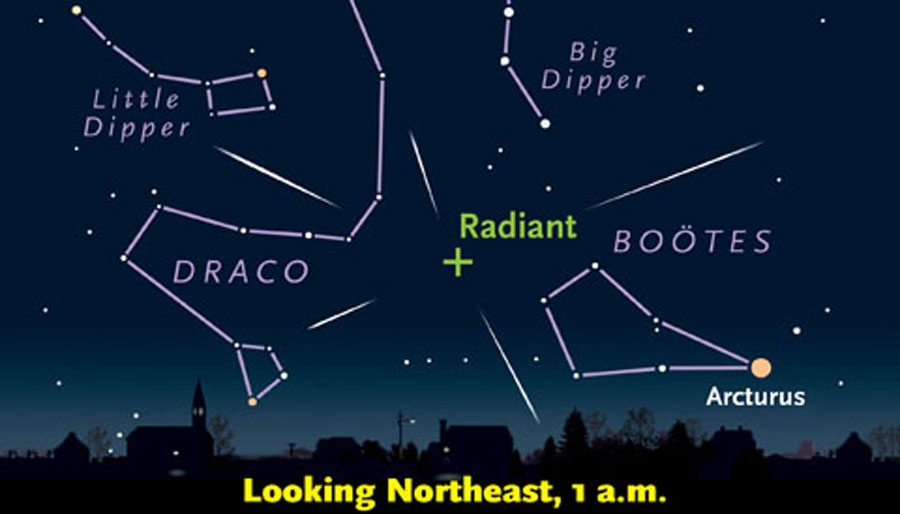
Sky & Telescope diagram
The 2022 Quads reach maximum around 20h40m UT (3:40 p.m. EST) on January 3, 2022, an ideal time if you live in Eastern Europe and Asia, where the peak happens during the early morning hours (local time) of Jan. 4. U.S. observers will miss the climax but still see modest activity (~25 per hour) between 1 a.m. and dawn local time on Monday, Jan. 3. Because of the shower's afternoon timing, East Coast skywatchers may see slightly more Quads on the morning of Jan. 4 than the 3rd. Happily, the Moon will be just a half-day old and won't get in the way no matter where you watch.
The radiant is located in northern Boötes in the now-obsolete constellation of the Mural Quadrant (hence the shower name). From latitude 40° north it climbs to an altitude of nearly 20° by 1 a.m. local time and stands more than 60° high at the start of morning twilight. If you live in the far northern U.S. and Canada, the radiant is circumpolar.
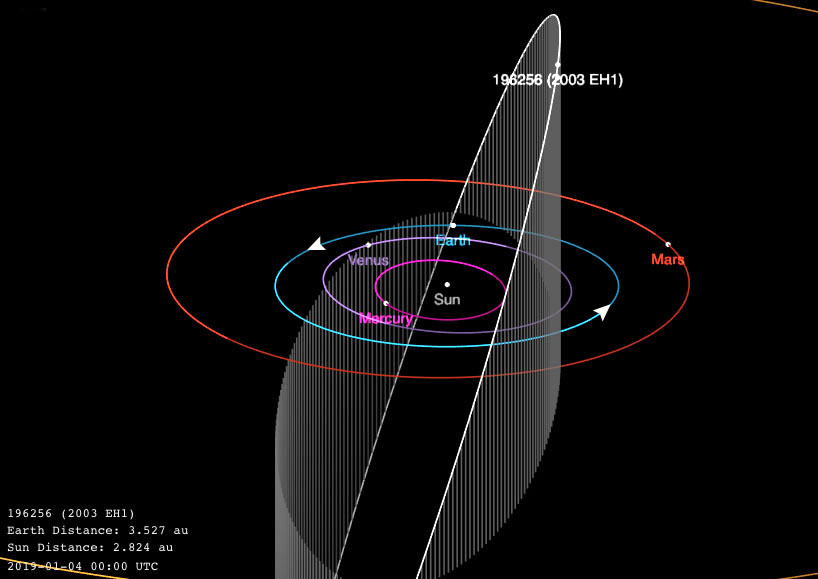
NASA / JPL Horizons
Quadrantid meteors originate from debris sloughed off by near-Earth asteroid 2003 EH1 and Comet 96P/Machholz. Every year from late December through mid-January, the Earth cuts across this stream. The material strikes the atmosphere at speeds around 41 kilometers per second (92,000 mph) and produces a flurry of meteors. The peak is brief because the densest part of the swarm is narrow, and we power through it perpendicularly.
Despite the continuing pandemic, the Quads offer us a chance to bring in the New Year year with hopeful spark and dazzle. Clear skies and stay well.
 5
5









Comments
Joe Stieber
December 22, 2021 at 3:43 pm
The caption for Ahmad's second image showing a single thin crescent Venus says it was taken two days before inferior conjunction on June 2, 2020. It's not clear if the time is for the image or the conjunction. Checking the USNO's MICA software, inferior conjunction was on June 3, 2020, at 17:44 UT, which was June 4, 1:44 am local time in Maylasia (UT+8, daylight time not observed). So, the image date is June 2, local time, June 1, UT.
I visually observed Venus from New Jersey on June 1, 2020, around 4 pm EDT (UT-4) That would be around 20:00 UT on June 1, so I was looking about 46 hours before new when Venus was about 3° east of the sun. I had an excellent sun blocking arrangement, and with my 88 mm apo spotting at 60x, I was able to constantly see the extremely thin crescent for a third of the planet's circumference, and in moments of better seeing, a complete ring. Of all the many photographs I've seen of Venus near that conjunction, none could match the sublime visual view I had. The crescent was distinctly thinner than shown in any of the photos.
I've been looking forward to catching Venus on the day of the upcoming inferior conjunction on January 8, 2022, when Venus will pass almost 5° north of the sun. I've tried for the wide passes in the past, but the weather hasn't cooperated. The June 2020 conjunction was too close to try (half a degree center-to center, so only a quarter of a degree from the solar limb). For the inferior conjunction of October 26, 2018, when Venus passed about 6° south of the sun, it was cloudy. However, I did see it on six preceding dates in October, including the day before, Oct 25, when Venus was 6.6° from the sun.
You must be logged in to post a comment.
Bob KingPost Author
December 22, 2021 at 10:05 pm
Hi Joe,
It sounds like your June 1, 2020 view of the Venus crescent was most memorable. I can relate. No photo shows just how breathtakingly thin Venus becomes so close to conjunction. Regarding the time of Ahmad's image, I used the date and description included with the image in the caption. To clarify, the specific time was 1:30 UT June 2, 2020.
You must be logged in to post a comment.
Anthony Barreiro
December 22, 2021 at 4:55 pm
"Like the [fully shielded, warm spectrum, motion-activated] porch light that welcomes you home at night ... ."
Crescent Venus is one of my favorite sights, and a lot of fun to share with passersby through a small telescope. A spotting scope with a correctly oriented image makes it easier for people to visualize the geometry of the Sun, Venus, and Earth. Many people are surprised that they can see Venus during daylight or bright twilight. When Venus gets close to the Sun I play it safe by putting the Sun behind the edge of a building before I start scanning for Venus.
You must be logged in to post a comment.
Bob KingPost Author
December 22, 2021 at 10:10 pm
Hi Anthony,
Your description made me smile. But OF COURSE! I appreciate your witty and astronomically appropriate take on porch lighting. I hope you have some good opportunities to share the crescent Venus with the public this season.
You must be logged in to post a comment.
Anthony Barreiro
December 23, 2021 at 12:30 am
Sadly, because of the corona virus pandemic, I'm limiting my sidewalk astronomy to pointing out things people can see with their unaided eyes. It doesn't feel safe to have people breathing on my equipment, even with masks. The line-up of Venus, Saturn, and Jupiter has been great.
Hopefully we'll be able to safely share Venus' crescent phase in the summer of 2023.
You must be logged in to post a comment.
You must be logged in to post a comment.